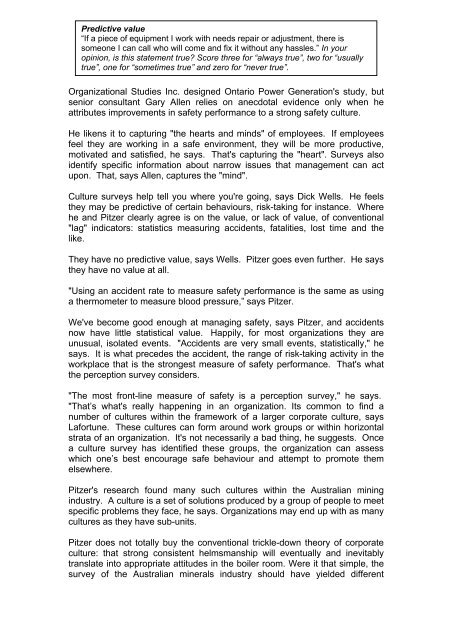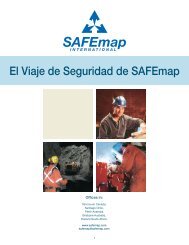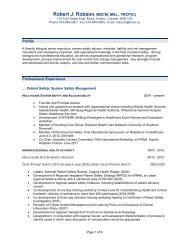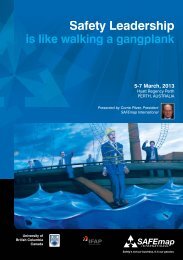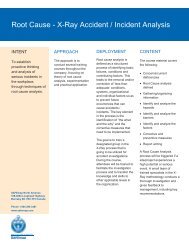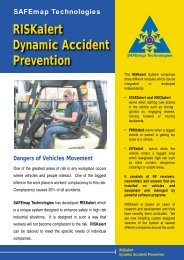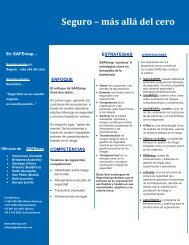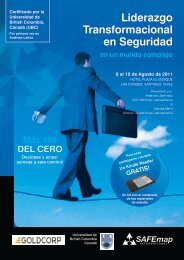A Matter of Perception - SAFEmap International
A Matter of Perception - SAFEmap International
A Matter of Perception - SAFEmap International
Create successful ePaper yourself
Turn your PDF publications into a flip-book with our unique Google optimized e-Paper software.
Predictive value“If a piece <strong>of</strong> equipment I work with needs repair or adjustment, there issomeone I can call who will come and fix it without any hassles.” In youropinion, is this statement true? Score three for “always true”, two for “usuallytrue”, one for “sometimes true” and zero for “never true”.Organizational Studies Inc. designed Ontario Power Generation's study, butsenior consultant Gary Allen relies on anecdotal evidence only when heattributes improvements in safety performance to a strong safety culture.He likens it to capturing "the hearts and minds" <strong>of</strong> employees. If employeesfeel they are working in a safe environment, they will be more productive,motivated and satisfied, he says. That's capturing the "heart". Surveys alsoidentify specific information about narrow issues that management can actupon. That, says Allen, captures the "mind".Culture surveys help tell you where you're going, says Dick Wells. He feelsthey may be predictive <strong>of</strong> certain behaviours, risk-taking for instance. Wherehe and Pitzer clearly agree is on the value, or lack <strong>of</strong> value, <strong>of</strong> conventional"lag" indicators: statistics measuring accidents, fatalities, lost time and thelike.They have no predictive value, says Wells. Pitzer goes even further. He saysthey have no value at all."Using an accident rate to measure safety performance is the same as usinga thermometer to measure blood pressure,” says Pitzer.We've become good enough at managing safety, says Pitzer, and accidentsnow have little statistical value. Happily, for most organizations they areunusual, isolated events. "Accidents are very small events, statistically," hesays. It is what precedes the accident, the range <strong>of</strong> risk-taking activity in theworkplace that is the strongest measure <strong>of</strong> safety performance. That's whatthe perception survey considers."The most front-line measure <strong>of</strong> safety is a perception survey," he says."That’s what's really happening in an organization. Its common to find anumber <strong>of</strong> cultures within the framework <strong>of</strong> a larger corporate culture, saysLafortune. These cultures can form around work groups or within horizontalstrata <strong>of</strong> an organization. It's not necessarily a bad thing, he suggests. Oncea culture survey has identified these groups, the organization can assesswhich one’s best encourage safe behaviour and attempt to promote themelsewhere.Pitzer's research found many such cultures within the Australian miningindustry. A culture is a set <strong>of</strong> solutions produced by a group <strong>of</strong> people to meetspecific problems they face, he says. Organizations may end up with as manycultures as they have sub-units.Pitzer does not totally buy the conventional trickle-down theory <strong>of</strong> corporateculture: that strong consistent helmsmanship will eventually and inevitablytranslate into appropriate attitudes in the boiler room. Were it that simple, thesurvey <strong>of</strong> the Australian minerals industry should have yielded different


